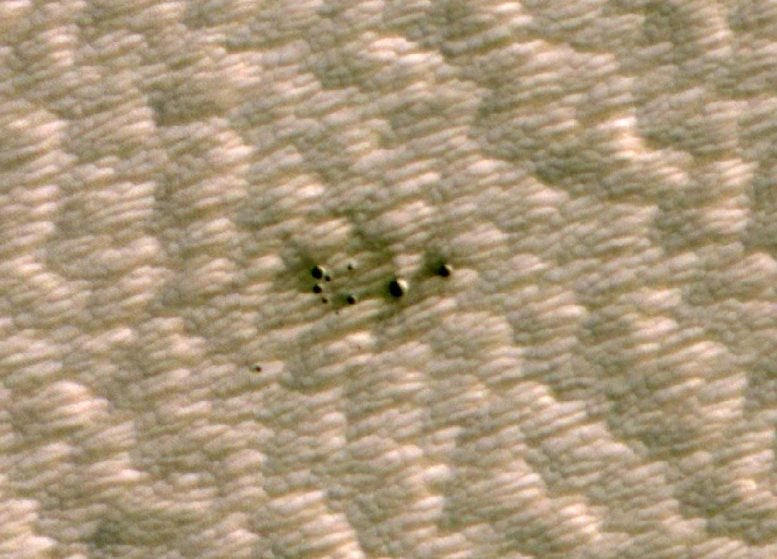The black spot in the lower left corner of this image is a collection of recently formed craters that were discovered on Mars using a new machine learning algorithm. This image was captured by the context camera aboard NASA’s Mars Reconnaissance Orbiter. Photo credit: NASA / JPL-Caltech / MSSS
It is the first time machine learning has been used to find previously unknown craters on the Red Planet.
Sometime between March 2010 and May 2012, a meteor shot across the Martian sky, shattered, and hit the surface of the planet. The resulting craters were relatively small – only 4 meters in diameter. The smaller the features, the more difficult it is to see them Mars Orbiter. But in this case – and for the first time – scientists discovered it with a little extra help: artificial intelligence (AI).
It is a milestone for planetary researchers and AI researchers at NASASouthern California’s Jet Propulsion Laboratory jointly developed the machine learning tool that contributed to the discovery. The achievement offers hope of both saving time and increasing the volume of reports.
Typically, scientists spend hours each day studying images captured by NASA’s Mars Reconnaissance Orbiter (MRO) and looking for changing surface phenomena like dust devils, avalanches, and moving dunes. In the 14 years of orbiter on Mars, scientists have relied on MRO data to find over 1,000 new craters. They are usually first detected by the spacecraft’s context camera, which is capturing low-resolution images over hundreds of kilometers at a time.

The HiRISE camera aboard NASA’s Mars Reconnaissance Orbiter captured this image of a cluster of craters on Mars, the first AI ever discovered. The AI first discovered the craters in images captured with the orbiter’s context camera. Scientists followed up with this HiRISE image to confirm the craters. Photo credit: NASA / JPL-Caltech / University of Arizona
In these images, only the traces of the explosion around an impact are highlighted, not the individual craters. The next step is to take a closer look at the High Resolution Imaging Science Experiment (HiRISE). The instrument is so powerful that it can see details as fine as the marks left by the Curiosity Mars rover. (The HiRISE team allows anyone, including members of the public, to request specific images through their HiWish page.)
The process takes patience and takes approximately 40 minutes for a researcher to carefully scan a single context camera image. To save time, JPL As part of a broader JPL initiative called COSMIC (Capturing Onboard Summarization to Monitor Image Change), the researchers developed a tool called an automated crater classifier for fresh impacts that develops technologies for future generations of Mars orbiters.
Learning the landscape
To train the crater classifier, the researchers fed it 6,830 contextual camera images, including those from locations with previously discovered effects that have already been confirmed via HiRISE. Images with no new impact have also been fed to the tool to show the classifier what not to look for.
After the training, the classifier was made available in the entire repository of the context camera with around 112,000 images. Running on a supercomputer cluster at JPL made up of dozens of high-performance computers that can work together. A process that takes 40 minutes only takes an average of five seconds.
One challenge was figuring out how to run up to 750 copies of the classifier simultaneously across the cluster, said JPL computer scientist Gary Doran. “It would not be possible to process more than 112,000 images in a reasonable time without spreading the work over many computers,” said Doran. “The strategy is to break the problem down into smaller pieces that can be solved in parallel.”
Despite all this computing power, the classifier still needs a human to check its work.
“AI cannot do the kind of skilled analysis a scientist can do,” said JPL computer scientist Kiri Wagstaff. “However, tools like this new algorithm can be your assistants. This paves the way for an exciting symbiosis of human and AI researchers working together to accelerate scientific discovery. ”
On August 26, 2020, HiRISE confirmed that a dark spot detected by the classifier in a region called Noctis Fossae was in fact the collection of craters. The team has already submitted more than 20 additional candidates for HiRISE to check out.
While this crater classifier is running on earth based computers, the ultimate goal is to develop similar classifiers tailored for use by future Mars orbiters on board. For the data to be sent back to Earth, scientists are currently looking for interesting images, much like trying to find a needle in a haystack, said Michael Munje, a Georgia Tech graduate student who interned on the classifier at JPL.
“The hope is that in the future the AI could prioritize orbital images that scientists are more interested in,” said Munje.
Ingrid Daubar, a scientist with appointments from JPL and Brown University who was also involved in the work, hopes the new tool can provide a more complete picture of how often meteors hit Mars, and small impacts in areas too points out in which they were not discovered earlier. The more craters that are found, the more scientists are expanding our knowledge of the size, shape and frequency of meteorite impacts on Mars.
“There are probably many more effects that we haven’t found yet,” she said. “This advancement shows you how much you can do with veteran missions like MRO using modern analytical techniques.”



